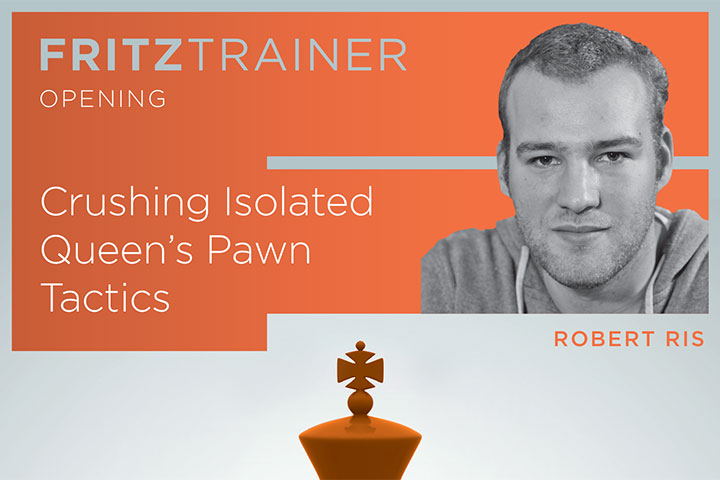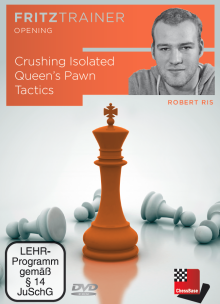


Crushing Isolated Queen's Pawn Tactics
The aim of this DVD is to offer the viewer tactical exercises that also illustrate the attacking prospects within IQP positions. The content of the DVD emphasizes the importance of understanding this type of pawn structure.
The subject of this DVD is absolutely essential for anyone serious about chess. There. Is. No. Excuse. Nonetheless, I must admit my personal reluctance in entering the study of such a complex topic, until the moment I felt ready. I know it is a fundamental step in my progress toward chess mastery. Often we mistake the Elo rating for chess knowledge. Instead, real chess knowledge is based upon the understanding of many pawn structures. The Isolated Queen's Pawn is one of those structures one must learn to play from both sides. This is my attempt to remedy this lack of knowledge in my own preparation.
Anatomy of an IQP
Ris begins with important definitions about the Isolated Queen Pawn (from now on abbreviated as IQP). As we can see from the diagram, in the endgame the IQP is a problem for the player who has it, because it is not supported, or protected, by other pawns. Ris' words resound with me, especially when he shares his evolution as player, since when he was younger he loved to play against the IQP, because he traded the pieces, entered in an endgame, and had a clear easy target to attack, the IQP itself. Instead now he grew to appreciate playing also as the side with the IQP, because there are some great attacking ideas which can be implemented in the middle game.

One example which comes to mind is the additional space afforded the player owning the IQP. This consequently helps him to develop the pieces, centralise, and mobilse them for an attack against the enemy king.
The main topic of the DVD is not about the positional treatment of the IQP, but the tactics which arise from positions with the IQP. A question the reader may have at this point in the review is: "how can that improve my chess?" Well, many advantages are "dynamic" not "static" which means they disappear with time, hence the need to be able to feel them, because as human beings we are not computers, and we need to learn how to feel what is right or wrong in a certain position. Then we need to learn how to exploit these dynamic advantages at the right moment. This is the reason why this DVD is an important milestone in our progress, because Ris has created videos based on more than 30 games, with the right training questions at important critical moments. Therefore this will help immensely to grow the feeling for finding the right move, and tactical idea, in positions with the IQP in our tournament games.
And what about the openings? One could have the faulty notion that the IQP appears only in 1.d4 openings, and in fact it's a common appearance in the Nimzo-Indian after the moves: 1.d4 Nf6 2.c4 e6 3.Nc3 Bb4 4.e3 b6 5.Bd3 Bb7 6.Nf3 0-0 7.0-0 c5 Bd2 cxd4 9.exd4 d5 10.cxd5 Nxd5:
And of course the list of openings can continue with the Queen's Gambit declined,
or the Queen's gambit accepted after the moves; 1.d4 d5 2.Nf3 Nf6 3.c4 dxc4 4.e3 e6 5.Bxc4 a6 6.0-0 c5 7.Bb3 Nc6 8.Nc3 cxd4 9.cxd4 Be7 10.Bg5 0-0 11.Qd2 Bd7 12.Rad1 where we have a typical IQP position:
We find it in the Tarrasch defense played with black.
But also in openings with 1.e4 like in the Sicilian Alapin after the moves: 1.e4 c5 2.c3 d5 3.exd5 Qxd5 4.d4 Nc6 5.Nf3 Bg4 6.Be2 cxd4 7.cxd4 e6:
And also in the Caro-Kann Panov variation we find the IQP.
Ris has selected positions mainly from White's perspective, but the IQP is common also in Black's positions, like in the French Tarrasch Black can have an IQP or also the Nimzo-Indian as Black after the moves: 1.d4 Nf6 2.c4 e6 3.Nc3 Bb4 4.Qc2 0-0 5.a3 Bxc3 6.Qxc3 b6 7.Bg5 Bb7 8.e3 d6 9.Ne2 Nbd7 10.Qc2 c5 11.Rd1 Qe7 12.Nc3 cxd4 13.Rxd4 h6 14.Bh4 Rfd8 15.f3 d5 16.cxd5 exd5:
In the Slav after the moves: 1.d4 d5 2.c4 c6 3.Nc3 Nf6 4.e3 a6 5.Nf3 b5 6.b3 Bg4 7.Bd2 Nbd7 8.h3 Bxf3 9.Qxf3 b4 10.Na4 e5! (notice how Black smartly decided to convert the position to an IQP, because he has a lot of counter-play!) 11.Rc1 Bd6 12.cxd5 cxd5 13.dxe5 Nxe5.
Ris didn't mention all these openings, but I wanted to prove the point for the reader who could be unaware of just how many openings can lead us into an IQP position. Obviously this list doesn't aim to be comprehensive for all openings and transpositions, but just gives an idea of the importance of knowing how to deal with such common pawn structure. Clearly one must know both sides in order to become a complete player, and, as mentioned before, it will happen in our own games!
Let's return to the reason why this DVD is a milestone for every serious chess player. From the games Ris has chosen, one can't avoid noticing the correct piece placement for both sides, because Ris chose some of the greatest chess names: Karpov, Andersson, Timman, Smyslov etc. each game shows how these champions fought successfully (or not) with and against the IQP. This wealth of examples, commented by a great player like Ris, will provides keen insight into understanding and evaluating the position, in a way we wouldn't have dreamt before! Here an example of good piece placement:
While Ris explains the position, he also asks questions. For instance, in the position above, white has more space and more active pieces, but how shall he continue, and why?
The practical training side of the DVD is quite important as well, because we don't want to absorb passively, as with reading a book, we want to be active learners, pondering what we would play in that position in a practical game. And if our choice is wrong we discover why, in order to better align ourselves to the thinking process of the professional.
Now for those who are curious, and want to see if their intuition was correct, here's the entire game, however the value of this game is in the video where Ris explains it, and interrogates the viewer:
Throughout the DVD, Ris serves as a skilled teacher in conveying the ideas and maneuvers at the disposal of the side with the IQP, such as in the following diagram, where he shows a rook lift and identifies its targets:
Tactical ideas related to attacking the king castled on the kingside are covered in more depth in another Chessbase DVD dedicated specifically to the topic from Valeri Lilov.
Attacking a king which has castled short
Every chess coach preaches that attacking a stranded king in the centre is the easiest thing to do, but how about attacking a king which has already castled? More often than not kings hide on the kingside, right? So, that’s a good reason for you to know how to attack a king which has castled short. FM Valeri Lilov is glad to help you in this tricky business! His DVD focuses on a number fool-proof plans and techniques for successfully destroying the enemy’s fortress to bring the opponent’s king to justice!
Once more we can see the advantage of the Chessbase interactive format; like many pieces of a puzzle, the different DVDs all compete to form our chess persona, and facilitate our progress towars master level understanding!
Ris has provided a wealth of examples, some just with the skeleton of pawns around the black king, in order to show how one should attack, and open the position. In the following diagram one can see an example of the maneuvers and ideas Ris discusses to explain what we should do, and why, and then we see those ideas happening in real games shown in the videos.
The DVD also come with a database of 64 annotated model games which one must study in order to better understand the topic. This give us the best of two worlds. One world is the DVD with an international master level player teaching us visually and verbally how to play against or with the IQP, the other world would be a chess book — and this is there too via the 64 model games, which allow us to add our own annotations or ideas, further improving our understanding of the subject.
As a final note, I'd like to share one last game I found amazing, because it shows many of the themes Ris teaches us in the DVD.
Crushing Isolated Queen's Pawn Tactics
The aim of this DVD is to offer the viewer tactical exercises that also illustrate the attacking prospects within IQP positions. The content of the DVD emphasizes the importance of understanding this type of pawn structure.